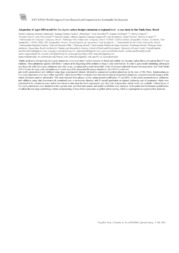Adaptation of Agro-IBIS model for Eucalyptus carbon budget estimation at regional level: a case study in São Paulo State, Brazil.
Adaptation of Agro-IBIS model for Eucalyptus carbon budget estimation at regional level: a case study in São Paulo State, Brazil.
Autoria: COLMANETTI, M. A. A.; CUADRA, S. V.; ATTIA, A.; NOUVELLON, Y.; GUILLEMOT, J.; CAMPOE, O. C.; CABRAL, O. M. R.; LACLAU, J.; GALDOS, M.; LAMPARELLI, R.; BORTOLUCCI, J.; PEREIRA, B.; MAIRE, G. Le
Resumo: Highly productive fast-growing Eucalyptus plantations cover more than 5 million hectares in Brazil and exhibit very dynamic carbon fluxes throughout their 6-7 year rotations. These plantations quickly shift from C sources at the beginning of the rotation to large C sinks until harvest. In order to get a model simulating carbon pool and fluxes for both Eucalyptus plantations and other crops, we integrated several sub-models of the Eucalyptus-dedicated Generic Decomposition And Yield Model (G?DAY) into the large scale and multi-cover model Agro-IBIS (Integrated Biosphere Simulator). The G?DAY model was previously parametrized and validated using large experimental datasets obtained in commercial eucalypt plantations in the state of São Paulo. Implementing an Eucalyptus plantation cover type within AgroIBIS, which had no Plant Functional Type dedicated to fast-growing forest plantations, required important changes in the carbon allocation turnover sub-models. This study included three phases: (1) the computational modification of AgroIBIS; (2) the model parametrization, calibration and validation using data fromintensively monitored sites or inventories datasets; and (3) model application at regional scaleusing sets of parameters which were considered to be constant in space and/or time based on data from the local experiments, and other sets of parameters which could vary spatially. Carbon fluxes of Eucalyptus plantations were simulated at the regional scale, and their inter-annual and spatial variabilities were analysed. Such spatial and multiannual quantification of carbon fluxesat large scalesbrings a better understanding of these forest ecosystems on global carbon cycling, which is a prerequisite to support policy decisions.
Ano de publicação: 2019
Tipo de publicação: Resumo em anais e proceedings
Unidade: Embrapa Meio Ambiente
Palavras-chave: Agro IBIS model, Carbono, Eucalipto
Observações
1 - Por padrão são exibidas publicações dos últimos 20 anos. Para encontrar publicações mais antigas, configure o filtro ano de publicação, colocando o ano a partir do qual você deseja encontrar publicações. O filtro está na coluna da esquerda na busca acima.
2 - Para ler algumas publicações da Embrapa (apenas as que estão em formato ePub), é necessário ter, no celular ou computador, um desses softwares gratuitos. Sistemas Android: Google Play Livros; IOS: iBooks; Windows e Linux: software Calibre.
Acesse outras publicações
Acesse a Base de Dados da Pesquisa Agropecuária (BDPA) para consultar o acervo completo das bibliotecas da Embrapa.

